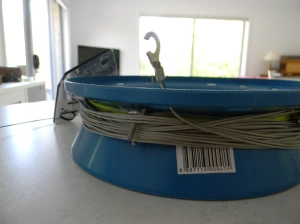EFHW portable antenna for SOTA activations
Mention to anyone you are using an EFHW will prompt a discussion about the pros and cons of the EFHW versus the center fed 1/2 wave dipole. There are operators who swear their center fed 1/2 wave dipole is 2 S points better than the EFHW and vice versa. I am neutral on this subject, I have built both antennas and can confirm when they are used in the real world, on top of a mountain, neither antenna is better than the other. Choosing one antenna over another is about personal choice. The obvious difference between the two antennas is the feed point location and the feed point resistance. The EFHW is in the order of 3000 to 5000 ohms while the 1/2 wave dipole will be closer to 50 ohms in the inverted V configuration.
So why would you spend time making an EFHW and a standard 1/2 wave dipole? I made the 1/2 wave dipole for the convenience factor when the summit is marked by a trig. Trigs are excellent supports for a squid pole and generally have concrete pads to place the gear on. For a trig summit I use the 1/2 wave dipole fed by 10 metres of RG58AU coax.
In all other cases I use the EFHW why? The antenna is very light and only requires 1 or 2 metres of RG58AU feed line to the rig. The antenna wire is 1.2 mm 7 strand stainless steel 20.1 metres long. The beauty about the 7 strand wire is it doesn’t knot or tangle unless you deliberately try and is corrosion resistant. The antenna is wound on a 8 inch fishing line caster and clipped to the backpack with a D shackle.
The EFHW is supported in the center by a perspex plate which slips over the 9 metre squid pole. I use cable ties to clamp the plate to the tapered pole. The support plate sits about 500 mm below the top of the pole. The antenna is generally configured as an inverted V, however there have been occasions where I have mounted the antenna as a sloper. See Mt Ginger Ale post.
To match the EFHW to 50 ohms you will need a LC match. A poly variable capacitor and a small iron toroid will be suitable for QRP levels. The LC tuner is easy to build so why not make it yourself? Who inspired me to make an EFHW tuner? VK3YE Peter QRP guru and VK5ZVS Steph who uses stainless steel wire for kite antennas on the lower HF bands. Both sites offer a range of project material.
For my first attempt at making the LC match I housed the components in a small plastic food container containing a T80-2 red toroid 8:1 winding, 4 primary and 32 secondary, a 220 pf poly variable capacitor and binding posts for the antenna and earth attachment points. The counterpoise wire is 1 metre long as per the AA5TB design. Although the plastic container is small, it is bulky and takes up valuable space in the back pack. You can see the wasted space in the picture below. Regardless of project box issues, the LC match box is a good SOTA project.
Since making my first SOTA EFHW for 40m, I have constructed a SOTA link EFHW for 15/20/40m. See post update 8 Aug 14 – https://vk1nam.wordpress.com/2014/08/08/link-end-fed-half-wave-antenna-and-tuner-for-sota/







Pingback: 40 Meter EFHW Antenna | VK2GAZ's SOTA BLOG
Hi Garry, a good read.
I am preparing a new post for the EFHW. Hope to post on my blog in the next day or so.
73
Andrew,VK1NAM